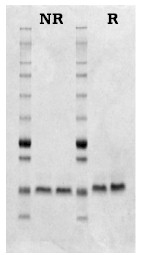Osteocalcin, also known as Bone-Gla-Protein (BGP), is a single chain (Mr=5800) vitamin K dependent protein produced by osteoblasts and found in high concentrations in bone (1-4). Post-translational modification by a vitamin K dependent carboxylase produces three g-carboxyglutamic acid residues at positions 17, 21 and 24. The mature protein contains 49 amino acids and a single intrachain disulfide bond joining Cys23 to Cys29. The secondary structure is highly calcium dependent and contains 14% α-helix, 20% β-sheet and 67% random form in the presence of calcium, and 1% α-helix, 20% β-sheet and 79% random form in the absence of calcium (4).
BGP binds to phospholipid vesicles in the presence of calcium ions (Kd=6 x 10-6 M) (5). BGP also binds hydroxyapatite and is an efficient inhibitor of hydroxyapatite seeded crystal growth, suggesting a regulatory role in bone mineralization (6). Although the fundamental role of BGP in vivo remains elusive, in vitro experimentation suggests roles in both bone resorption and bone formation. BGP has been shown to function as a chemo-attractant in an in vitro macrophage mediated bone resorption system. The serum concentration of BGP has been linked to bone formation rates, and BGP levels are currently used in research assessment of osteoporosis and other metabolic bone disease states (7).
Osteocalcin is prepared from bovine bone generally as described by Price et al. (1). This involves demineralization in EDTA, size exclusion and ion exchange chromatography. The purified protein is supplied 50 % (vol/vol) glycerol/0.01 M Tris, 0.075 M NaCl, pH 7.4, and should be stored at -20°C. Human osteocalcin is prepared from extracts of acid-demineralized bone, using immunoaffinity chromatography. The human protein is supplied in 0.02 M Tris, 0.15 M NaCl, 2 mM CaCl2, pH 7.4 and should be stored at -80°C. Purity is determined by SDS-PAGE.


